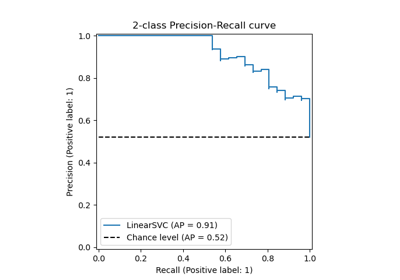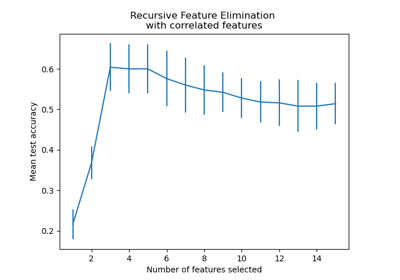注意
转到末尾以下载完整示例代码或通过 JupyterLite 或 Binder 在浏览器中运行此示例。
带交叉验证的网格搜索的自定义重新拟合策略#
此示例展示了如何通过交叉验证优化分类器,这是使用 GridSearchCV 对象在仅包含一半可用标记数据的开发集上完成的。
然后,在模型选择步骤中未使用的专用评估集上测量所选超参数和训练模型的性能。
有关可用于模型选择的工具的更多详细信息,请参见交叉验证:评估估计器性能和调整估计器的超参数部分。
# Authors: The scikit-learn developers
# SPDX-License-Identifier: BSD-3-Clause
数据集#
我们将使用 digits 数据集。目标是对手写数字图像进行分类。我们将其转换为二元分类问题以便于理解:目标是识别数字是否为 8。
from sklearn import datasets
digits = datasets.load_digits()
为了在图像上训练分类器,我们需要将它们展平为向量。每张 8x8 像素的图像需要转换为 64 像素的向量。因此,我们将得到一个形状为 (n_images, n_pixels) 的最终数据数组。
n_samples = len(digits.images)
X = digits.images.reshape((n_samples, -1))
y = digits.target == 8
print(
f"The number of images is {X.shape[0]} and each image contains {X.shape[1]} pixels"
)
The number of images is 1797 and each image contains 64 pixels
如引言中所述,数据将被分成大小相等的训练集和测试集。
from sklearn.model_selection import train_test_split
X_train, X_test, y_train, y_test = train_test_split(X, y, test_size=0.5, random_state=0)
定义我们的网格搜索策略#
我们将通过在训练集的折叠上搜索最佳超参数来选择分类器。为此,我们需要定义用于选择最佳候选者的分数。
scores = ["precision", "recall"]
我们还可以定义一个函数传递给 GridSearchCV 实例的 refit 参数。它将实现自定义策略,从 GridSearchCV 的 cv_results_ 属性中选择最佳候选者。一旦选择了候选者,它将由 GridSearchCV 实例自动重新拟合。
在这里,策略是筛选出在精确度和召回率方面最佳的模型。从选定的模型中,我们最终选择预测速度最快的模型。请注意,这些自定义选择是完全任意的。
import pandas as pd
def print_dataframe(filtered_cv_results):
"""Pretty print for filtered dataframe"""
for mean_precision, std_precision, mean_recall, std_recall, params in zip(
filtered_cv_results["mean_test_precision"],
filtered_cv_results["std_test_precision"],
filtered_cv_results["mean_test_recall"],
filtered_cv_results["std_test_recall"],
filtered_cv_results["params"],
):
print(
f"precision: {mean_precision:0.3f} (±{std_precision:0.03f}),"
f" recall: {mean_recall:0.3f} (±{std_recall:0.03f}),"
f" for {params}"
)
print()
def refit_strategy(cv_results):
"""Define the strategy to select the best estimator.
The strategy defined here is to filter-out all results below a precision threshold
of 0.98, rank the remaining by recall and keep all models with one standard
deviation of the best by recall. Once these models are selected, we can select the
fastest model to predict.
Parameters
----------
cv_results : dict of numpy (masked) ndarrays
CV results as returned by the `GridSearchCV`.
Returns
-------
best_index : int
The index of the best estimator as it appears in `cv_results`.
"""
# print the info about the grid-search for the different scores
precision_threshold = 0.98
cv_results_ = pd.DataFrame(cv_results)
print("All grid-search results:")
print_dataframe(cv_results_)
# Filter-out all results below the threshold
high_precision_cv_results = cv_results_[
cv_results_["mean_test_precision"] > precision_threshold
]
print(f"Models with a precision higher than {precision_threshold}:")
print_dataframe(high_precision_cv_results)
high_precision_cv_results = high_precision_cv_results[
[
"mean_score_time",
"mean_test_recall",
"std_test_recall",
"mean_test_precision",
"std_test_precision",
"rank_test_recall",
"rank_test_precision",
"params",
]
]
# Select the most performant models in terms of recall
# (within 1 sigma from the best)
best_recall_std = high_precision_cv_results["mean_test_recall"].std()
best_recall = high_precision_cv_results["mean_test_recall"].max()
best_recall_threshold = best_recall - best_recall_std
high_recall_cv_results = high_precision_cv_results[
high_precision_cv_results["mean_test_recall"] > best_recall_threshold
]
print(
"Out of the previously selected high precision models, we keep all the\n"
"the models within one standard deviation of the highest recall model:"
)
print_dataframe(high_recall_cv_results)
# From the best candidates, select the fastest model to predict
fastest_top_recall_high_precision_index = high_recall_cv_results[
"mean_score_time"
].idxmin()
print(
"\nThe selected final model is the fastest to predict out of the previously\n"
"selected subset of best models based on precision and recall.\n"
"Its scoring time is:\n\n"
f"{high_recall_cv_results.loc[fastest_top_recall_high_precision_index]}"
)
return fastest_top_recall_high_precision_index
调整超参数#
定义了选择最佳模型的策略后,我们定义超参数的值并创建网格搜索实例
from sklearn.model_selection import GridSearchCV
from sklearn.svm import SVC
tuned_parameters = [
{"kernel": ["rbf"], "gamma": [1e-3, 1e-4], "C": [1, 10, 100, 1000]},
{"kernel": ["linear"], "C": [1, 10, 100, 1000]},
]
grid_search = GridSearchCV(
SVC(), tuned_parameters, scoring=scores, refit=refit_strategy
)
grid_search.fit(X_train, y_train)
All grid-search results:
precision: 1.000 (±0.000), recall: 0.854 (±0.063), for {'C': 1, 'gamma': 0.001, 'kernel': 'rbf'}
precision: 1.000 (±0.000), recall: 0.257 (±0.061), for {'C': 1, 'gamma': 0.0001, 'kernel': 'rbf'}
precision: 1.000 (±0.000), recall: 0.877 (±0.069), for {'C': 10, 'gamma': 0.001, 'kernel': 'rbf'}
precision: 0.968 (±0.039), recall: 0.780 (±0.083), for {'C': 10, 'gamma': 0.0001, 'kernel': 'rbf'}
precision: 1.000 (±0.000), recall: 0.877 (±0.069), for {'C': 100, 'gamma': 0.001, 'kernel': 'rbf'}
precision: 0.905 (±0.058), recall: 0.889 (±0.074), for {'C': 100, 'gamma': 0.0001, 'kernel': 'rbf'}
precision: 1.000 (±0.000), recall: 0.877 (±0.069), for {'C': 1000, 'gamma': 0.001, 'kernel': 'rbf'}
precision: 0.904 (±0.058), recall: 0.890 (±0.073), for {'C': 1000, 'gamma': 0.0001, 'kernel': 'rbf'}
precision: 0.695 (±0.073), recall: 0.743 (±0.065), for {'C': 1, 'kernel': 'linear'}
precision: 0.643 (±0.066), recall: 0.757 (±0.066), for {'C': 10, 'kernel': 'linear'}
precision: 0.611 (±0.028), recall: 0.744 (±0.044), for {'C': 100, 'kernel': 'linear'}
precision: 0.618 (±0.039), recall: 0.744 (±0.044), for {'C': 1000, 'kernel': 'linear'}
Models with a precision higher than 0.98:
precision: 1.000 (±0.000), recall: 0.854 (±0.063), for {'C': 1, 'gamma': 0.001, 'kernel': 'rbf'}
precision: 1.000 (±0.000), recall: 0.257 (±0.061), for {'C': 1, 'gamma': 0.0001, 'kernel': 'rbf'}
precision: 1.000 (±0.000), recall: 0.877 (±0.069), for {'C': 10, 'gamma': 0.001, 'kernel': 'rbf'}
precision: 1.000 (±0.000), recall: 0.877 (±0.069), for {'C': 100, 'gamma': 0.001, 'kernel': 'rbf'}
precision: 1.000 (±0.000), recall: 0.877 (±0.069), for {'C': 1000, 'gamma': 0.001, 'kernel': 'rbf'}
Out of the previously selected high precision models, we keep all the
the models within one standard deviation of the highest recall model:
precision: 1.000 (±0.000), recall: 0.854 (±0.063), for {'C': 1, 'gamma': 0.001, 'kernel': 'rbf'}
precision: 1.000 (±0.000), recall: 0.877 (±0.069), for {'C': 10, 'gamma': 0.001, 'kernel': 'rbf'}
precision: 1.000 (±0.000), recall: 0.877 (±0.069), for {'C': 100, 'gamma': 0.001, 'kernel': 'rbf'}
precision: 1.000 (±0.000), recall: 0.877 (±0.069), for {'C': 1000, 'gamma': 0.001, 'kernel': 'rbf'}
The selected final model is the fastest to predict out of the previously
selected subset of best models based on precision and recall.
Its scoring time is:
mean_score_time 0.005081
mean_test_recall 0.877206
std_test_recall 0.069196
mean_test_precision 1.0
std_test_precision 0.0
rank_test_recall 3
rank_test_precision 1
params {'C': 100, 'gamma': 0.001, 'kernel': 'rbf'}
Name: 4, dtype: object
通过网格搜索和我们的自定义策略选择的参数是
grid_search.best_params_
{'C': 100, 'gamma': 0.001, 'kernel': 'rbf'}
最后,我们在留出的评估集上评估微调后的模型:grid_search 对象已使用我们自定义重新拟合策略选择的参数在整个训练集上自动重新拟合。
我们可以使用分类报告计算留出集上的标准分类指标
from sklearn.metrics import classification_report
y_pred = grid_search.predict(X_test)
print(classification_report(y_test, y_pred))
precision recall f1-score support
False 0.99 1.00 0.99 807
True 1.00 0.87 0.93 92
accuracy 0.99 899
macro avg 0.99 0.93 0.96 899
weighted avg 0.99 0.99 0.99 899
注意
问题太简单了:超参数平台过于平坦,精确度和召回率的输出模型相同,存在平局。
脚本总运行时间: (0 minutes 10.200 seconds)
相关示例



